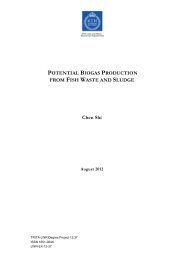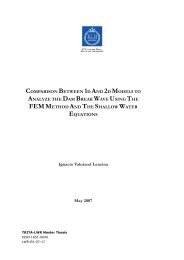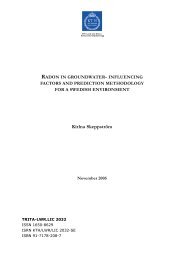FrequencyWater <strong>sources</strong>, <strong>infrastructure</strong>, <strong>space</strong> <strong>and</strong> <strong>the</strong> <strong>dynamics</strong> <strong>of</strong> environmental diseases in Saboba District: Using GISScenario: If Environmental Diseases were Reduced by Half700006000050000400003000020000Total <strong>of</strong> Top 10 Diseases BurdenScenario (Reduce Environmentaldiseases by Half)1000002002 2003 2004 2005YearFigure 4: A Scenario showing environmental diseases being reduced by half in SabobadistrictManagement <strong>of</strong> <strong>water</strong> re<strong>sources</strong> in Saboba districtThe past <strong>and</strong> <strong>the</strong> present <strong>water</strong> management practices are compared <strong>and</strong>contrast in this section. This is to enable me make conclusion on which<strong>of</strong> <strong>the</strong> <strong>water</strong> governing system is most effective in <strong>the</strong> district.Management <strong>of</strong> <strong>water</strong> re<strong>sources</strong>: History before 1988This section presents <strong>and</strong> analyses information derived fromunstructured interviews <strong>and</strong> discussions with chiefs, Umoadanbor (riverchief),older people <strong>and</strong> opinion leaders. The <strong>water</strong> <strong>sources</strong> available in<strong>the</strong> district were mainly from Oti basin, streams, dams <strong>and</strong> natural wells.In <strong>the</strong> past, <strong>water</strong> bodies were fully in <strong>the</strong> h<strong>and</strong>s <strong>of</strong> <strong>the</strong> Umoadanbor,chiefs <strong>and</strong> village leaders. The Umoadanbor ((in all cases male, <strong>and</strong> mostly<strong>the</strong> eldest in <strong>the</strong> village/town) were <strong>the</strong> custodians <strong>of</strong> <strong>the</strong> <strong>water</strong> (riverineforest included). The Umoadanbor <strong>and</strong> sometimes with Utindan (l<strong>and</strong>chief)perform sacrifices to <strong>the</strong> gods to usher in <strong>water</strong> re<strong>sources</strong> for yetano<strong>the</strong>r farming <strong>and</strong> fishing seasons to conform to micro-climaticconditions <strong>of</strong> <strong>the</strong> area. One could not by-pass Utindan <strong>and</strong> Umoadanbor in<strong>the</strong> use <strong>of</strong> any <strong>of</strong> <strong>the</strong>se re<strong>sources</strong> (e.g. fishing) under <strong>the</strong>ir jurisdiction. Asa result, <strong>water</strong> re<strong>sources</strong> were always under control in terms <strong>of</strong> itsutilisation. The Umoadanbor usually appoints a person from <strong>the</strong>community as <strong>water</strong> security guard to enforce strict rules; while customarylaws, conventions <strong>and</strong> norms restricted majority <strong>of</strong> <strong>the</strong> people frompolluting it. This is <strong>the</strong> system under which Nana Ofori Atta II notion <strong>of</strong>natural re<strong>sources</strong> management works. With several interviews <strong>and</strong>discussions with <strong>the</strong> elders in <strong>the</strong> communities, it was revealed that <strong>the</strong>beginning <strong>of</strong> erosion <strong>of</strong> authorities <strong>and</strong> powers <strong>of</strong> <strong>the</strong> Umoadanbor,Utindan <strong>and</strong> o<strong>the</strong>r local leaders coincided (<strong>and</strong> in fact a consequence <strong>of</strong>)government’s 1988 Decentralisation Policy that created <strong>the</strong> districtassemblies with <strong>the</strong> highest local authority <strong>and</strong> power. Therefore, <strong>the</strong>period before 1988 Decentralisation Policy is herein referred to as <strong>the</strong>“past” (governed by customary laws) while 1988 onwards is referred toas <strong>the</strong> “present” (mainly controlled by government/district laws).19
Mat<strong>the</strong>w Biniyam KursahTRITA LWR Master ThesisWater management: traditional value system <strong>and</strong> <strong>the</strong> modern positivismLike most parts in Ghana during <strong>the</strong> period <strong>of</strong> low population growth<strong>and</strong> localisation <strong>of</strong> <strong>water</strong> re<strong>sources</strong> as well as market, <strong>the</strong> intergenerationalequity was <strong>and</strong> could be safeguarded in Saboba district. Thiswas sustained by <strong>the</strong> traditional management practices <strong>of</strong> <strong>the</strong> use <strong>of</strong><strong>water</strong> re<strong>sources</strong>. Quite <strong>of</strong>ten, <strong>the</strong> socio-cultural ideologies <strong>and</strong>philosophies mostly inclined on cultures were been used for <strong>the</strong>protection <strong>of</strong> <strong>water</strong> which was considered sacred in <strong>the</strong> district. Theseindigenous strategies are usually predicated on customs <strong>and</strong> traditionsthat have strong totemic significance, as <strong>the</strong>y were h<strong>and</strong>ed-down fromancestral lineages (Benneh et al, 1998 <strong>and</strong> Toulmin et al, 2002). It isinteresting to note that those norms were more respected <strong>and</strong> compliedwith in <strong>the</strong> communities within <strong>the</strong> district due largely to <strong>the</strong>irapprehensive consequences. Some management strategies included <strong>the</strong>use <strong>of</strong> moral laws <strong>and</strong> taboos, restrictions, adherence to religious beliefs<strong>and</strong> sometimes outright ban-on-use <strong>of</strong> certain sections/whole <strong>of</strong> <strong>water</strong>body when its vulnerability to contamination seems imminent. Some<strong>water</strong> <strong>and</strong> o<strong>the</strong>r natural re<strong>sources</strong> were been deified. Thus, like <strong>the</strong> biblicalprohibitions thy shall not or taboos, were enshrined in <strong>the</strong> value systemsto control <strong>the</strong> use <strong>of</strong> environment that will have health repercussions onpeople. Within <strong>the</strong> district for example, one was forbidden to send acooking pot (usually dirty) to riverside or cut vegetation along rivervalleys. The rationale was to reduce <strong>water</strong> pollution <strong>and</strong> siltation as aresult <strong>of</strong> downstream erosion <strong>of</strong> river/stream courses, respectively.Offenders were seen as invoking <strong>the</strong> spirits <strong>of</strong> limoawaal (river-gods)which will punish <strong>the</strong>m accordingly, hence giving credence to <strong>the</strong> view <strong>of</strong>Nana Ofori Atta II.However, <strong>the</strong> incorporation <strong>of</strong> <strong>the</strong> district, like any part in Ghana, into<strong>the</strong> modern system, decentralisation policy, rapid population growth,changes in socio-economic conditions <strong>and</strong> lifestyle have led to <strong>the</strong>relegation <strong>of</strong> <strong>the</strong>se traditional management practices <strong>of</strong> <strong>the</strong> use <strong>of</strong> <strong>water</strong>.Thus, <strong>the</strong> use <strong>of</strong> <strong>water</strong> re<strong>sources</strong> in <strong>the</strong> district is now largely governedby <strong>the</strong> modern positivist view <strong>of</strong> <strong>the</strong> relationship between society <strong>and</strong>nature. The pr<strong>of</strong>it motive ra<strong>the</strong>r than <strong>the</strong> previous value systemsregulating <strong>water</strong> <strong>and</strong> environment control this current perspective view.The goal <strong>of</strong> positivism is to achieve objectivity in problem solving.Therefore, issues relating to <strong>the</strong> subjective world <strong>of</strong> value systems (suchas thy shall not or taboos) are now regarded as unscientific <strong>and</strong> hence notworth exploring (Kendie, 1997). In most cases <strong>the</strong>se are seen as obstaclesto be eliminated (Goulet, 1986). The ordinary person can now use <strong>water</strong>re<strong>sources</strong> <strong>and</strong> vegetation along it without any control by ei<strong>the</strong>rtraditional authority or District Assembly. As one respondent fromBordagbalm echoed; “d<strong>and</strong>ana aabiim aah ki pak iiyaajakaar” (<strong>the</strong> youth <strong>of</strong>today don’t longer respect ancestral laws).Currently, management <strong>and</strong> protection <strong>of</strong> <strong>water</strong> re<strong>sources</strong> is one <strong>of</strong> <strong>the</strong>least concerns in <strong>the</strong> district. Water is left to suffer <strong>the</strong> Hardin’s Tragedy <strong>of</strong><strong>the</strong> Common syndrome, as a woman respondent stated if clo<strong>the</strong>s are dirty, weuse <strong>water</strong> to wash it. So, Karaachi (intellectual) what can be used to wash <strong>water</strong> too?(my translation). Illiteracy <strong>and</strong> total lack <strong>of</strong> health concerns play a criticalrole in this case. As a result, <strong>the</strong> traditional norms <strong>and</strong> value systemsgoverning <strong>the</strong> relationship between nature <strong>and</strong> society have beenreplaced in <strong>the</strong> district by <strong>the</strong> modern positivist view. However, modernpositivism has not been able to adopt adequate practices <strong>and</strong> methods tosustain <strong>water</strong> re<strong>sources</strong>. The effect <strong>of</strong> this changing perception onenvironment, <strong>and</strong> specifically <strong>water</strong> use, has contributed to a20
- Page 1 and 2: Supervisor: Ulla MortbergCo-supervi
- Page 3 and 4: Water sources, infrastructure, spac
- Page 5 and 6: Water sources, infrastructure, spac
- Page 7 and 8: Water sources, infrastructure, spac
- Page 9 and 10: Water sources, infrastructure, spac
- Page 11 and 12: Water sources, infrastructure, spac
- Page 13 and 14: Water sources, infrastructure, spac
- Page 15 and 16: Water sources, infrastructure, spac
- Page 17 and 18: Matthew Biniyam KursahTRITA LWR Mas
- Page 19 and 20: Matthew Biniyam KursahTRITA LWR Mas
- Page 21 and 22: Matthew Biniyam KursahTRITA LWR Mas
- Page 23 and 24: Matthew Biniyam KursahTRITA LWR Mas
- Page 25 and 26: OberadeYusungaManieBilyimbaMatthew
- Page 27 and 28: Matthew Biniyam KursahTRITA LWR Mas
- Page 29 and 30: Matthew Biniyam KursahTRITA LWR Mas
- Page 31 and 32: Matthew Biniyam KursahTRITA LWR Mas
- Page 33: Matthew Biniyam KursahTRITA LWR Mas
- Page 37 and 38: Matthew Biniyam KursahTRITA LWR Mas
- Page 39 and 40: Matthew Biniyam KursahTRITA LWR Mas
- Page 41 and 42: PercentagePercentageMatthew Biniyam
- Page 43 and 44: Matthew Biniyam KursahTRITA LWR Mas
- Page 45 and 46: Matthew Biniyam KursahTRITA LWR Mas
- Page 47 and 48: Matthew Biniyam KursahTRITA LWR Mas
- Page 49 and 50: BilyimbaMatthew Biniyam Kursah Nadu
- Page 51 and 52: ManieBilyimbaBaguliMatthew Biniyam
- Page 53: ManieBilyimbaMatthew Biniyam Kursah
- Page 56 and 57: Matthew Biniyam KursahTRITA LWR Mas
- Page 58 and 59: Matthew Biniyam KursahTRITA LWR Mas
- Page 60 and 61: Matthew Biniyam KursahTRITA LWR Mas
- Page 62 and 63: Matthew Biniyam KursahTRITA LWR Mas
- Page 64 and 65: Matthew Biniyam KursahTRITA LWR Mas
- Page 66 and 67: PercentagesPercentagesMatthew Biniy
- Page 68 and 69: PercentagesMatthew Biniyam KursahTR
- Page 70 and 71: Matthew Biniyam KursahTRITA LWR Mas
- Page 72 and 73: Matthew Biniyam KursahTRITA LWR Mas
- Page 74 and 75: Matthew Biniyam KursahTRITA LWR Mas
- Page 76 and 77: Matthew Biniyam KursahTRITA LWR Mas
- Page 78 and 79: Matthew Biniyam KursahTRITA LWR Mas
- Page 80 and 81: Matthew Biniyam KursahTRITA LWR Mas
- Page 82 and 83: Matthew Biniyam KursahTRITA LWR Mas
- Page 84 and 85:
Matthew Biniyam KursahTRITA LWR Mas
- Page 86 and 87:
Matthew Biniyam KursahTRITA LWR Mas
- Page 88 and 89:
Matthew Biniyam KursahTRITA LWR Mas
















